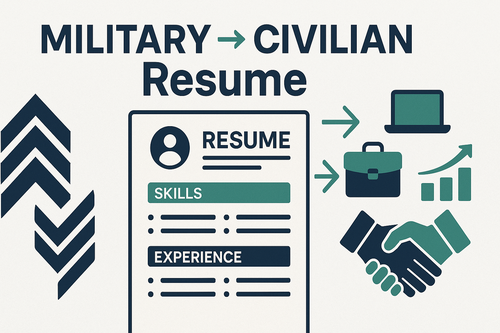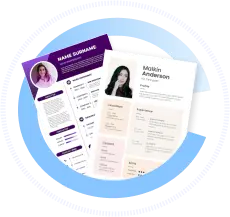Military-to-Civilian Resume (Translate MOS to Skills)
A military-to-civilian resume focuses on translating Military Occupational Specialty (MOS) roles into civilian job skills and experiences. In 2025, the key to success lies in creating an ATS-optimized, skills-driven resume that bridges military experience with industry expectations and highlights your readiness for civilian employment.
| What to Include (At a Glance) |
|---|
| Translate MOS titles into civilian-friendly roles |
| Highlight transferable skills and leadership |
| Reframe military projects and commendations |
| Address career gaps or transitions positively |
The Challenge (Recruiter Perspective)
Recruiters may have difficulty interpreting military jargon and assessing the applicability of military experience because:
- MOS titles and duties are unfamiliar
- Military language does not align with ATS keywords
- Concerns about adapting to civilian workplace culture
- Difficulty verifying non-traditional experience
Clear translation of military terms and emphasizing transferable skills reduces these barriers.
Choose the Right Format to De-Emphasize Gaps
- The combination resume is most effective, presenting a strong skills summary upfront followed by military and civilian work history.
- Group military experience by skill themes or leadership roles rather than only chronologically.
- Include sections for training, certifications, and volunteer/community involvement.
Reframe Experience (Skills, Projects, Volunteering)
- Convert MOS-specific tasks into universally understood skills (e.g., leadership, logistics, problem-solving).
- Quantify achievements: numbers, scope, budgets, teams led.
- Include volunteer or veteran network activities to show engagement and continuous growth.
Language Examples You Can Adapt
- MOS: “Infantry Squad Leader” → Civilian: “Team Leader, coordinating and training teams in high-pressure environments.”
- MOS: “Supply Chain Specialist” → Civilian: “Managed logistical operations including inventory, distribution, and vendor relations.”
- Emphasize soft skills like adaptability, discipline, and communication critical to civilian roles.
How to Explain Gaps in Applications
- Briefly acknowledge career transitions or deployments in your summary or cover letter.
- Focus on skills and experiences gained during gaps (training, education, leadership).
- Maintain a confident, forward-looking tone.
ATS Considerations
- Use civilian job titles and keywords relevant to your target industry.
- Avoid military acronyms or jargon without civilian equivalents.
- Use clear headings and bullet points for readability.
- Submit as ATS-friendly DOCX or PDF files.
Templates & Checklist
| Military-to-Civilian Resume Checklist |
|---|
| Civilian-friendly job titles replacing MOS codes |
| Detailed skills summary highlighting leadership & soft skills |
| Quantifiable achievements & project descriptions |
| Relevant certifications, training, and volunteer work included |
| ATS-compatible layout with relevant keywords |
Copy-Ready Example (Combination Format)
Skills Summary
- Team Leadership & Training
- Logistics & Supply Chain Management
- Project Coordination & Execution
- Risk Assessment & Problem Solving
Military Experience
Team Leader (Infantry Squad Leader) | U.S. Army | 2015–2022
- Led a team of 12 soldiers, conducting operations under high-pressure conditions.
- Developed training programs improving team readiness by 40%.
- Managed logistics planning, equipment maintenance, and resource allocation.
Volunteer & Training
- Participated in veteran mentorship programs supporting workforce reintegration.
- Completed Project Management Professional (PMP) certification in 2024.
FAQ
Q: How do I translate my MOS to civilian jobs?
A: Use online MOS translation tools and focus on transferable skills and accomplishments.
Q: Should I list ranks or military awards?
A: Include ranks briefly and highlight awards that demonstrate leadership and achievement.
Q: How long should my resume be?
A: Typically 1-2 pages focusing on relevant civilian skills.
Q: Do I need to explain military terms?
A: Always provide civilian-friendly explanations or equivalents.


